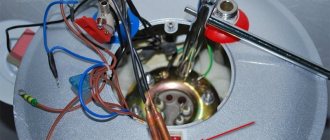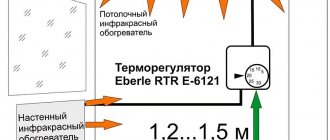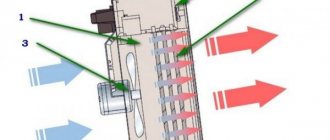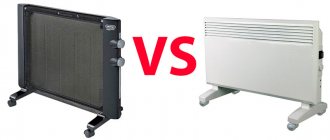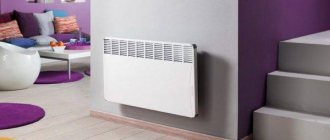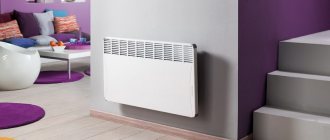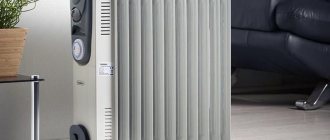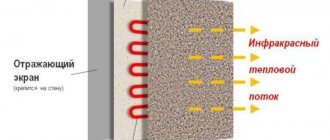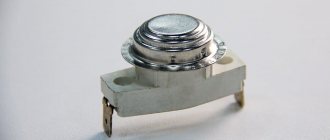For several years now, new generation heaters have been widely represented on our market, which at the same time are a stylish decorative item.
We are talking about wall-mounted film heaters in the form of picturesque paintings. They work on the principle of infrared radiation. Are they really as effective as manufacturers say, what are the features of their operation, and are they worth the money? Let's take a closer look.
First, let's look at all their advantages, which they certainly have, and then we'll go over the significant disadvantages. There is little talk about them in commercials and stores.
Advantages over conventional heaters
One of the main advantages due to which many housewives look at these warming wall paintings and panels is their appearance and the ability to further decorate the interior of the apartment.
A single apartment owner can also choose the model he likes.
In addition to using them at home, they can also be used at work by hanging the picture directly near the workplace. In many offices, the use of fan heaters or heat blowers is officially prohibited due to their fire hazard.
But with such a heater there are no problems.
Forgot to install a heated floor or a separate radiator on your balcony or loggia?
And here this wonderful infrared device will help you out. Moreover, such warming paintings can be hung on walls made of any material.
The heating temperature of the surface of the film wall heater does not exceed 65-75 degrees. Therefore, it is simply impossible to get burned by accidental contact here.
Because of this, many people use them in children's rooms. For example, the most common oil radiators, which seem to be reliably protected on all sides and do not have open heating elements, are highly not recommended for use in children's rooms.
Kinds
Manufactured in the form of a picture, film electric heaters have a flexible base and are extremely lightweight.
Among the 2 in 1 assortment you can find models in the form of:
- carbon structures;
- stylish design made of quartz or ceramics;
- halogen and microthermal heating devices.
Important! Film design, which looks like a painting, poster, panel, is best placed near the workplace. This is the best option that will provide a comfortable environment, while maintaining comfort in the cool or damp seasons - winter, off-season (autumn/spring).
Painting-heater in the interior
How it works and what heats it up
Picture heaters work on the principle of the sun. Only here infrared rays are emitted by special carbon fibers.
They are insulated on top with eco-film, onto which a colorful image is applied.
Of course, the canvas itself heats up a little during operation, but as mentioned above, you won’t be able to get burned on it. If you touch the surface with your palm, you will initially feel some warmth.
However, it disappears almost instantly and after a second the hand already feels as if it were at room temperature. This effect is achieved through a zone shutdown system.
That is, as soon as the picture heater feels pressure on the surface of the tracks, they automatically turn off. This is a kind of protection against overheating and failure.
The main heating here occurs on the surface to which the painting is directly directed. It is not the air itself that is heated.
This could be a sofa, a bed, or you yourself sitting at your desk. This will create the feeling that a bright, warm sun is shining on you.
Film painting heater – how does it work?
Today, the problem of space heating has many solutions. One of the popular options is the use of wall-mounted picture heaters .
The principle of their operation is based on the conversion of infrared rays into thermal energy, which is released into the room, including reflection from heated objects. A picture heater is a small format film plate, usually less than 1 square meter, which is framed with a wooden frame and looks like a picture.
You can buy a painting of a heater here.
How to choose - rules and features
There are always two convex strips at the top and bottom of the film heater. They prevent the painting from being pressed tightly against the wall surface.
When purchasing, pay attention to what these planks are made of. We recommend clean wood, without any coating with varnishes or paints.
Glued laminated timber would also be a bad option.
Such a heater will emit unpleasant and harmful odors during operation. These planks also provide the required distance from the wall of 2 cm.
This is necessary not only for fire safety reasons, but also to preserve the surface of the walls in their original form. For example, for some users, with prolonged use, the wallpaper begins to peel off in places where the picture is hung.
Conventional heaters and wind blowers raise dust, dry the air, and burn out oxygen. And they constantly get in the way.
With their frequent use, headaches, dry mouth and other signs of oxygen starvation occur. Warming paintings do not dry out the air and do not reduce oxygen levels in your home.
Even if dust collects on them, they do not burn it and you will not feel the corresponding smell. You can keep them on for a whole day.
Moreover, unlike simple heaters, the average power of wall film almost never exceeds 400-500W.
They are turned on through a regular outlet. At the same time, you do not have to upgrade the electrical panel or run a separate line, as for warm electric floors.
Although, of course, you may be limited by the length of the cord with the plug and the location of the nearest outlets. It is not recommended to connect them via extension cords.
Don't want continuous 24/7 work? Connect heating pictures and panels through the socket timer.
Thus, you can automatically set the optimal heating mode for the room.
Well, it is best to purchase film wall heaters equipped with a built-in temperature sensor. It hides between the lower wooden planks.
Thus, it will be impossible for the product to overheat and in emergency situations it will turn off when the temperature is exceeded.
Of the most popular models, products under the brands “Velvet Season”, “Home Hearth”, “Dobroe Teplo” are the most widespread.
And such a heating device can easily be rolled up into a tube and stored in a small box until the next cold weather.
Try hiding the bulky oil battery as well. Some of our compatriots even manage to take such wall paintings with them on long trips around Europe.
All hotels there have permafrost. Especially in autumn and spring.
What is the advantage of film wall heaters in the form of pictures?
Wall picture heaters, which have a number of undeniable advantages, are becoming increasingly popular:
- Low energy consumption.
- High efficiency.
- Safety.
- Quick effect.
- Lightweight and easy to attach.
- Attractive appearance.
- Environmentally friendly (does not dry out the air).
The device operates from a 220V network, consuming from 300 to 500 Watts depending on the type of model.
However, as the main advantage of electric heaters , it should be noted that heat is generated due to the reflection of infrared radiation, including from interior items, which completely eliminates the harmful drying of air.
In addition, efficiency is ensured by the low energy consumption and high efficiency of devices in this category.
Disadvantages and cons
And now, after a colorful description of all the advantages, it’s worth talking about the disadvantages. One of the main ones is still insufficient power. As you know, to heat a room of 10 m2, on average, 1 kW of power is required.
These heaters are good in very small rooms. Don’t expect any miracles from one single picture hung in your bedroom or living room.
For example, such a film heater will never be able to raise the temperature from 18 degrees to 25. Yes, you can direct radiation from it to the bed and warm it up to a comfortable temperature. But this can be done much more efficiently and quickly using a heated blanket or sheet.
To specifically increase the temperature in the apartment, your walls should be literally hung with such warming paintings. And in this case, just forget about free sockets.
As you yourself understand, talking in this case about energy efficiency and some kind of savings would be simply ridiculous.
If you want to warm up a small room, close all the windows and entrance doors to it. Only after a day will you really be able to feel the temperature rise by several degrees.
Heating in the bathroom
Many people hang this picture in the bathroom. Especially if there is some kind of defect on the tile. She can cover him great.
However, even here, to increase the temperature by only 1 degree, it will take at least one hour of operation of the device. It is more reliable and safer to make a stationary electric coil or heated towel rail.
At the same time, do not forget about humidity and place the panel only in the permitted area, as well as the socket for connecting it.
The shell protection class of most devices does not exceed IP20.
Therefore, you cannot constantly keep them in a damp bathroom. You will have to bring the device in while it warms up, and then immediately remove it from the stud.
By the way, many people miss the point of reliable fastening and hang this electrical product at random. They even manage to hook it with a pin, so as not to damage the walls.
Meanwhile, this is one of the main factors of safe operation. Some users have had cases when the film heater came off the stud and its heating strips fell directly onto the power cord.
You can read the consequences in the review.
Color change and workmanship
Another disadvantage is changing the background of the picture. If you initially chose a painting in white tones, then do not be surprised that over time it may turn yellow.
And black stripes of carbon thread will clearly protrude on the front side.
Therefore, it is advisable to choose film heating patterns in dark colors, without bright contrasting patterns. Otherwise, even if the heater works properly, after some time you will be ashamed to hang such a yellowed miracle in front of your guests.
By the way, paper and wallpaper that are directly exposed to infrared rays for a long time turn yellow in the same way as they do from the sun.
These devices quickly reach the set temperature (from 10 seconds to a minute), but they cool down almost instantly after they are unplugged. There is no talk here of any inertia like that of oil batteries, or even more so, like that of heated floors.
And when purchasing, carefully check the integrity of all current-carrying paths. We are, of course, not talking about outright handicraft, which is revealed by the naked eye.
But even high-quality goods during transportation or storage in a warehouse can get caught or scratched by something. The heating may and will work, but it is clearly not the 50 thousand hours declared by the manufacturer.
Fire hazard and operating rules
You can find reviews on the Internet with information that such products are a fire hazard and at one “wonderful” moment they can burst into blue flame.
To prevent this from happening to you, do not buy cheap Chinese products without certificates and follow the basic rules for using film heating pads:
- the canvas can be rolled into a tube, but it must not be bent at right angles
- cannot be included in the network in an unexpanded state
- It is forbidden to cover the top with any kind of cloth, especially to lie down on it, putting it in bed instead of a sheet under the mattress
Many manufacturers place this warning on the front of the product.
- You also can’t use them to dry things by hanging compartments or fruit in the closet.
There are other specially designed devices for this.
- long-term use in damp areas without appropriate IP protection
It turns out that such heating paintings should under no circumstances be considered as an independent type of room heating. Otherwise you will be very disappointed in them.
But to maintain a comfortable temperature on cool autumn evenings, when full heating has not yet been provided, or it simply does not exist (for example, at the dacha), they can come in handy.
But here, too, proceed from the heating area - one film infrared picture with a power of 500 W per 10 m2.
If the room is larger, add the number of heaters accordingly. This is assuming you have a well-insulated and energy-efficient home overall.
Advantages and disadvantages
Among the advantages of the 2 in 1 design it is worth highlighting;
- ease of operation and the resulting effect in relatively compact rooms (up to 10 m2);
- there is no discomfort or lack of fresh air even when the equipment is running for days;
- compactness and mobility - such devices are easy to take with you (rolled up into a tube) not only to the country, on trips, but also to the office;
- often picture heaters are used as a local heating source;
- warming up the area, providing pleasant warmth, the wall-mounted unit does not dry out the air.
Important! A significant disadvantage is the relatively low power of the device.
Over time, such panels turn yellow, so it is recommended to choose designs with a darker color palette.
